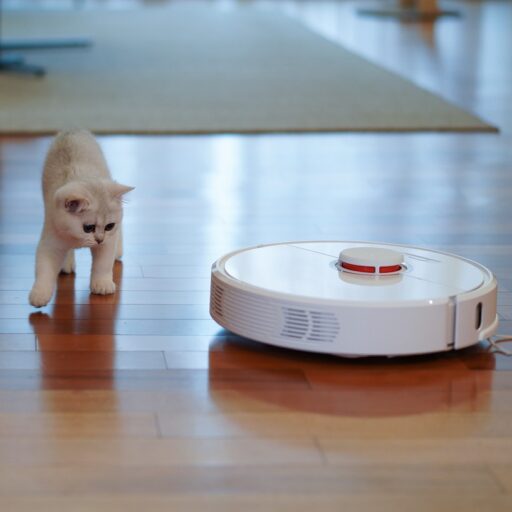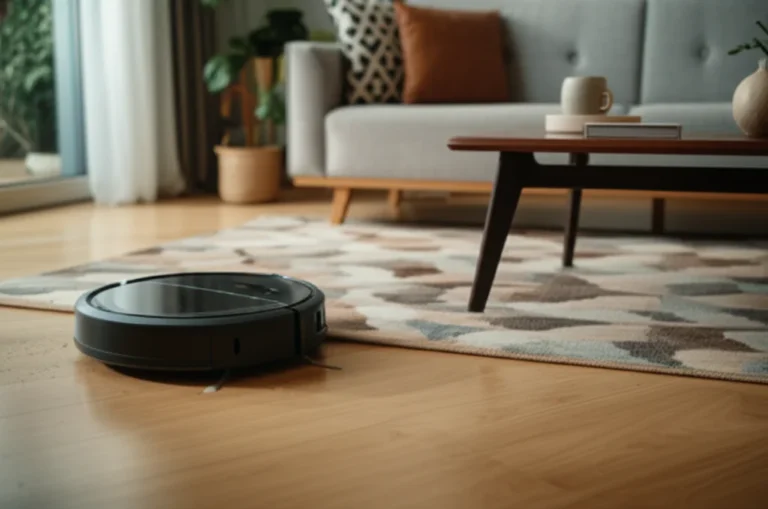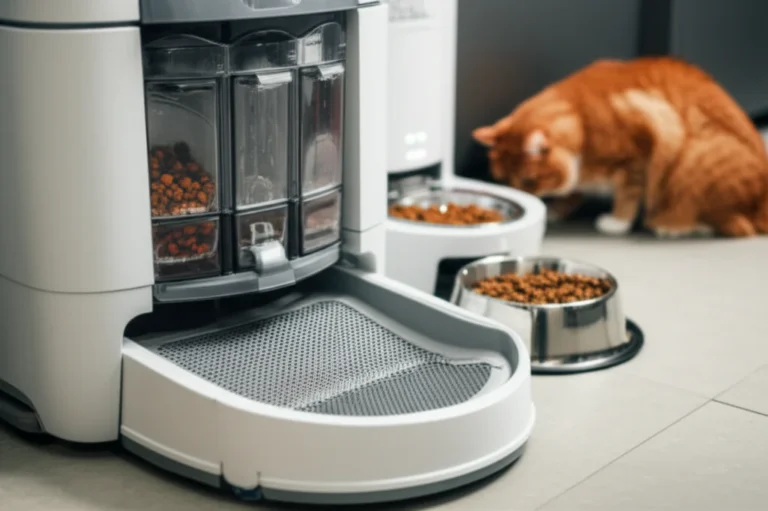Support our educational content for free when you purchase through links on our site. Learn more
The Ultimate Guide to Choosing the Right Robot Vacuum for You [2024] 🤖
Remember that time you tried to vacuum and ended up tangled in the cord? 🤯 Or maybe you’ve dreamed of coming home to a sparkling clean house while actually enjoying your free time? Robot vacuums are no longer a futuristic fantasy—they’re an everyday reality, and picking the right one can make a world of difference in your cleaning routine. In this comprehensive guide, we’ll cover everything from navigation technology to maintenance tips, helping you find the perfect robot vacuum that fits your needs, budget, and lifestyle.
Quick Answer
Want to know the best robot vacuum in 2024? It depends on your needs!
- For the average user: Consider brands like iRobot (Roomba), Roborock, Shark, Eufy, and Ecovacs.
- For a small apartment: Opt for a compact, efficient model like the Eufy RoboVac 11S.
- For pet owners: Look for powerful suction, dual rubber brushes, and maybe even tangle-free brushrolls.
- For allergy sufferers: HEPA filtration and a sealed system are essential.
- For large homes: Choose a model with long battery life, automatic recharging, and room mapping features.
👉 Shop Robot Vacuum Brands:
- iRobot (Roomba): Amazon | Walmart | iRobot Official Website
- Roborock: Amazon | Walmart | Roborock Official Website
- Shark: Amazon | Walmart | Shark Official Website
- Eufy: Amazon | Walmart | Eufy Official Website
- Ecovacs: Amazon | Walmart | Ecovacs Official Website
Table of Contents
- Quick Tips and Facts
- The Rise of the Robot Vacuum: A Brief History
- Types of Robot Vacuums: Navigating the Options
- Key Features to Consider: Choosing the Right Robot Vacuum for You
- Top Robot Vacuum Brands: A Comparative Guide
- Robot Vacuum vs. Traditional Vacuum: The Ultimate Showdown
- Robot Vacuum Maintenance: Keeping Your Cleaning Companion in Tip-Top Shape
- Robot Vacuum for Pet Owners: Taming the Furry Frenzy
- Robot Vacuum for Allergies: Breathe Easy with a Clean Home
- Robot Vacuum for Hardwood Floors: Maintaining Your Shine
- Robot Vacuum for Carpets: Deep Cleaning for a Plush Feel
- Robot Vacuum for Small Spaces: Tiny Homes, Big Cleaning Power
- Robot Vacuum for Large Homes: Covering Every Inch with Ease
- Robot Vacuum for Smart Homes: Integration and Automation
- Robot Vacuum Safety: Keeping Your Home and Robot Safe
- Robot Vacuum Troubleshooting: Common Issues and Solutions
- Conclusion
- Recommended Links
- FAQ
- Reference Links
Quick Tips and Facts 📌
- Robot vacuums work best for maintenance cleaning: Think of them like your daily cleaning assistant. They’re great at keeping up with dust bunnies and pet hair tumbleweeds between your regular deep cleans! 🤣
- Suction power matters, but it’s not everything: While a higher Pa (Pascal) rating generally indicates better suction (source), factors like brush design and navigation play a crucial role too. Think of it like this – would you rather have a strong but clumsy cleaner or a slightly less strong one that’s super thorough? 🤔
- Smart features can simplify your life: Features like app control, scheduling, and smart home integration can make your robot vacuum an integral part of your smart home ecosystem. You can have your house sparkling clean before you even step in the door! ✨ Check out our article on Robotics for more smart home tech insights.
- Check for replacement parts availability: Just like your car needs regular maintenance, so does your robot vacuum. Ensuring replacement parts are readily available can save you headaches down the line. ⚠️
- **Don’t forget about maintenance: ** A well-maintained robot vacuum will serve you better and longer. This includes regularly cleaning brushes, emptying the dustbin, and replacing filters. Think of it as giving your cleaning buddy a well-deserved spa day! 🧖♀️
The Rise of the Robot Vacuum: A Brief History 📰
The idea of a self-cleaning home has been a dream for ages (we’re looking at you, Jetsons!). While we haven’t quite achieved the flying car dream yet, the robot vacuum has made significant strides in making our lives easier.
- The Early Days (late 1990s – early 2000s): Remember the Electrolux Trilobite? This little guy, launched in 1997, was a pioneer in the robot vacuum world. Although clunky and limited by today’s standards, it paved the way for the sophisticated machines we see today.
- The iRobot Revolution (2002): The launch of the Roomba in 2002 marked a turning point. iRobot popularized the concept of robot vacuums, making them more mainstream and accessible.
- The Rise of the Smart Vacuum (2010s): With advancements in sensor technology and artificial intelligence, robot vacuums became smarter. They started featuring mapping, app control, and even voice assistant integration! 🤖
- Today: The robot vacuum market is booming! From budget-friendly options to high-end models with self-emptying bins and mopping capabilities, there’s a robot vacuum out there for almost everyone.
This evolution is a testament to the advancements in Robotics Engineering, bringing us closer to a future where robots seamlessly integrate into our lives. For more on how robots are transforming our world, check out our category on Robotics.
Types of Robot Vacuums: Navigating the Options 🧪
Choosing the right robot vacuum is like picking the perfect pair of shoes. You need to consider your needs, lifestyle, and, of course, your budget! Let’s navigate the different types of robot vacuums available:
1. Basic Robot Vacuums
- Best for: Small apartments, first-time users, budget-conscious shoppers
- Features: Basic navigation, often relying on bump-and-go sensors, may lack advanced features.
- What to expect: They get the job done, but might bump into furniture and require manual assistance for navigation.
Examples:
2. Smart Mapping Robot Vacuums
- Best for: Larger homes, users who want more control and efficiency
- Features: Use sensors like LiDAR or vSLAM to create maps, allowing for systematic cleaning, zone cleaning, and no-go zones.
- What to expect: More efficient cleaning, reduced bumping into obstacles, and greater control over cleaning cycles.
Examples:
- Roborock S7 Amazon | Roborock Official Website
- Shark IQ Robot Vacuum Amazon | Shark Official Website
3. Robot Vacuum and Mop Hybrids
- Best for: Users who want a single device for both vacuuming and mopping
- Features: Combine vacuuming with mopping capabilities, some models offer advanced mopping features like self-cleaning mop pads
- What to expect: Convenient two-in-one functionality, but mopping effectiveness can vary. Some models may require manual intervention for tasks like refilling the water tank.
Examples:
- Roborock S7 MaxV Amazon | Roborock Official Website
- iRobot Braava Jet m6 Amazon | iRobot Official Website
4. Self-Emptying Robot Vacuums
- Best for: Users seeking maximum convenience and minimal interaction with the robot vacuum
- Features: Come with a base station that automatically empties the dustbin, extending the time between manual emptying
- What to expect: Less frequent dustbin emptying, but often come with a higher price tag.
Examples:
- iRobot Roomba j7+ Amazon | iRobot Official Website
- Shark IQ XL Robot Self-Empty Amazon | Shark Official Website
Key Features to Consider: Choosing the Right Robot Vacuum for You 🤖
Now that you have a general idea of the different types of robot vacuums available, let’s delve into the specific features you should consider when choosing one for your home:
1. Navigation and Mapping
- LiDAR: Uses lasers to map your home. Highly accurate but can be more expensive. Imagine a robot vacuum with a laser vision, precisely mapping every nook and cranny! 🔥
- vSLAM: Uses cameras to map and navigate. More affordable but can be less accurate in low light. Think of it as a robot vacuum with a photographic memory, learning the layout as it goes. 📷
- Random Navigation: As the name suggests, they randomly navigate until they bump into something. Basic and affordable, but not very efficient. 🤦
2. Suction Power (Pa)
- Higher Pa = Stronger Suction: Important for homes with pets, carpets, or a lot of debris.
- Consider your needs: For mainly hardwood floors and light cleaning, a lower Pa model might suffice. No need to buy a heavy-duty vacuum for a studio apartment unless you’re planning on building sandcastles! 🏖️
3. Brush Design
- Dual Rubber Brushes: Generally considered the best, especially for picking up pet hair from different surfaces. Think of it as having two sets of hands, efficiently grabbing everything in their path! 🙌
- Bristle and Rubber Brush Combinations: Suitable for various surfaces, but may not be as effective on pet hair.
4. Battery Life and Charging Time
- Consider the size of your home: Longer battery life is crucial for larger spaces.
- Charging time varies: Some models offer fast charging options for quick cleanups.
5. Dustbin Capacity
- Larger capacity = less frequent emptying: Important for larger homes or users with pets.
- Self-emptying base: A game-changer for convenience, but adds to the cost. Imagine never having to empty the dustbin again…well, almost! 😀
6. Smart Features and App Control
- Scheduling: Set cleaning cycles for specific times and days. Your robot vacuum will be like your reliable cleaning crew, showing up on schedule! 📅
- Zone Cleaning: Target specific areas for cleaning.
- App Integration: Control your robot vacuum remotely and monitor cleaning progress.
- Voice Control: Control your robot vacuum with voice commands via Alexa, Google Assistant, etc. Talk about putting your feet up! 🥲
7. Additional Features
- Object Recognition: Some advanced models can identify and avoid obstacles like pet waste. No more unwanted surprises! 💩
- Carpet Boost: Automatically increases suction on carpets for deeper cleaning.
- Edge Cleaning: Dedicated side brushes to ensure edges and corners are clean.
8. Price
- Set a realistic budget: Robot vacuum prices can range from a few hundred dollars to over a thousand. Our 💸 What’s the Price Tag for a Cleaner Home in 2024? 🤖 article at https://robotinstructions.com/how-much-is-a-robot-vacuum-cleaner/ provides a detailed price breakdown for different robot vacuum models.
- Consider the features that matter most to you.
By carefully considering these features, you can choose a robot vacuum that fits your lifestyle and budget. 💰
Top Robot Vacuum Brands: A Comparative Guide 🏆
Choosing a robot vacuum brand can be like picking a favorite sports team – there’s a lot of brand loyalty out there! Each brand has its strengths and weaknesses. Here’s a look at some of the most popular robot vacuum brands to help you decide which team to root for:
| Brand | Strengths | Weaknesses | Example Product |
|---|---|---|---|
| iRobot (Roomba) | Pioneer in the industry, known for reliable navigation and strong brand reputation | Can be expensive, some models lack advanced features found in competitors | Roomba j7+ |
| Roborock | Offers excellent value for money, innovative features, and strong cleaning performance | Relatively newer brand compared to iRobot, app interface could be more user-friendly | Roborock S7 MaxV |
| Shark | Known for powerful suction, innovative features like self-cleaning brushrolls, and competitive pricing | Mapping and navigation might not be as refined as iRobot or Roborock | Shark IQ XL Robot Self-Empty |
| Eufy | Offers budget-friendly options without compromising on essential features, user-friendly app | May lack some advanced features of higher-end brands, some models have basic navigation | Eufy RoboVac 11S Max |
| Ecovacs | Offers a range of models with advanced features, competitive pricing, strong mopping performance on some models | App interface can be overwhelming, some users report durability issues | Ecovacs Deebot Ozmo T8 AIVI |
Shopping Links:
- iRobot (Roomba) Official Website: https://www.irobot.com/
- Roborock Official Website: https://us.roborock.com/
- Shark Official Website: https://www.sharkclean.com/mop/
- Eufy Official Website: https://us.eufylife.com/
- Ecovacs Official Website: https://www.ecovacs.com/us/
This table is just a starting point, and it’s important to do your own research based on your specific needs and budget. We’ll be covering more specific use cases and recommendations in later sections! 👇
Robot Vacuum vs. Traditional Vacuum: The Ultimate Showdown 🥊
It’s the age-old question (well, at least since robot vacuums became a thing): Is a robot vacuum enough, or do you still need a traditional vacuum cleaner? Let’s settle this debate:
Robot Vacuum Pros:
- Convenience: This is a no-brainer! Just set it and forget it (or schedule it, even better!). They clean while you work, sleep, or binge-watch your favorite show. 📺
- Maintenance Cleaning: Great for keeping up with daily dust, crumbs, and pet hair, especially on hard floors.
- Hard-to-Reach Areas: Their low profile allows them to reach under furniture, something traditional vacuums often struggle with.
Robot Vacuum Cons:
- Deep Cleaning: They generally don’t have the same suction power as traditional vacuums, especially on carpets.
- Spot Cleaning: Not ideal for quick cleanups of specific spills or messes.
- Stairs: They can’t climb stairs (yet—though we’re working on it!).
Traditional Vacuum Pros:
- Powerful Suction: Offers greater cleaning power, especially for deep cleaning carpets and upholstery.
- Versatility: Can be used on various surfaces, including furniture, stairs, and even cars.
- Spot Cleaning: Perfect for quick cleanups of localized messes.
Traditional Vacuum Cons:
- Manual Labor: You have to do all the work, which isn’t fun!
- Storage: Can be bulky and difficult to store.
The Verdict: It’s a Draw! 🏆
Ultimately, the best solution for most is to have both a robot vacuum and a traditional vacuum. The robot vacuum can handle daily maintenance cleaning, while a traditional vacuum can be used for deep cleans and specific tasks. It’s all about working smarter, not harder! 💪 Check out our article on Robotic Applications in Home Cleaning for more on how robotics is changing the way we clean our homes.
Robot Vacuum Maintenance: Keeping Your Cleaning Companion in Tip-Top Shape 🧹
Just like any other appliance, your robot vacuum needs some TLC to stay in peak cleaning condition. Regular maintenance will not only ensure efficient cleaning but also prolong the lifespan of your cleaning companion. Here’s a handy checklist:
Regular Maintenance Tasks:
- Empty the dustbin: Do this after every cleaning cycle, or more frequently if you have a large home or pets. Imagine going to work with a full trash can – not a pleasant thought, right? 🗑️
- Clean the brushes: Pet hair, human hair, and other debris can get tangled around the brushes, reducing their effectiveness. Remove the brushes and clear any blockages.
- Clean or replace the filter: A clogged filter can reduce suction power and even damage your robot vacuum. Check your manufacturer’s instructions for cleaning or replacement guidelines.
- Wipe down the sensors: Sensors are the eyes and ears of your robot vacuum, helping it navigate. Keep them clean with a soft, dry cloth.
- Check and clean the wheels: Dirt and debris can build up on the wheels, affecting navigation. Remove any obstructions and wipe the wheels clean.
Maintenance Schedule:
- After every cleaning cycle: Empty the dustbin.
- Every 1-2 weeks: Clean the brushes and wipe down the sensors.
- Every 3-6 months: Clean or replace the filter, depending on usage and the manufacturer’s recommendations.
- Annually: Give your robot vacuum a thorough checkup, including cleaning the wheels and checking for any signs of wear and tear.
By following these simple maintenance tips, you can keep your robot vacuum running smoothly for years to come. After all, a clean home is a happy home, and a happy robot vacuum makes for a happy home owner! 😊
Robot Vacuum for Pet Owners: Taming the Furry Frenzy 🐾
If you live with furry friends, you know the struggle of pet hair is real! Luckily, robot vacuums can be a lifesaver for pet owners. Here’s what to look for:
Essential Features:
- Strong Suction: Look for a vacuum with a Pa rating of at least 5,000 to effectively pick up pet hair from various surfaces.
- Dual Rubber Brushes: These are a must-have for pet hair! They effectively grab hair from both hard floors and carpets, preventing tangles.
- Larger Dustbin: A larger dustbin capacity means less frequent emptying, especially if your furry friend sheds like it’s going out of style!
- Tangle-free Brushroll (Optional): Some models have specially designed brushrolls that minimize hair tangles.
- Object Recognition (Optional): This advanced feature can identify and avoid pet accidents, saving you from an unpleasant cleaning situation.
Recommended Models for Pet Owners:
- iRobot Roomba j7+: Equipped with object recognition, powerful suction, and a self-emptying base station.
- Roborock S7 MaxV: Offers a combination of strong suction, dual rubber brushes, and advanced mopping capabilities – perfect for tackling pet messes!
- Shark IQ XL Robot Self-Empty: Features powerful suction, a self-cleaning brushroll, and a large dustbin capacity.
Remember: Even the best robot vacuums may require occasional help. Keep a traditional vacuum handy for those fur-ocious shedding seasons! 🐾
Robot Vacuum for Allergies: Breathe Easy with a Clean Home 🤧
For allergy sufferers, a clean home is more than just an aesthetic preference; it’s vital for maintaining good health. Here’s how robot vacuums can help:
What to look for:
- HEPA Filter: HEPA filters trap tiny particles, such as dust mites, pollen, and pet dander, that can trigger allergies. Make sure the filter is certified by a reputable organization, such as the Asthma and Allergy Foundation of America (AAFA).
- Sealed System: A sealed system ensures that all the dust and allergens collected stay trapped inside the vacuum and don’t escape back into the air.
- Regular Cleaning: Regularly clean or replace the filter, as recommended by the manufacturer, to maintain optimal performance.
Additional Tips for Allergy Sufferers:
- Vacuum Frequently: Regular cleaning will help to keep allergen levels low.
- Choose Hard Floors: Hard floors are easier to keep clean than carpets, which can trap allergens.
- Wash Bedding Frequently: Wash bedding in hot water at least once a week to kill dust mites.
- Use Air Purifiers: Consider using air purifiers in bedrooms and other frequently used rooms.
By combining a high-quality robot vacuum with these additional measures, allergy sufferers can create a cleaner and healthier home environment. 🥰
Robot Vacuum for Hardwood Floors: Maintaining Your Shine ✨
Hardwood floors add a touch of elegance to any home, but keeping them clean can feel like a never-ending battle against dust bunnies and pet hair. Here’s how robot vacuums can become your hardwood floor heroes:
Desirable Features:
- Good Navigation System: Look for a robot vacuum with systematic navigation, like LiDAR or vSLAM, to avoid unnecessary collisions with furniture.
- Soft-touch Bumpers: Some models have bumpers with soft-touch materials to prevent scratches or marks on delicate hardwood floors.
- Adjustable Suction Power: Adjust the suction power to suit the cleaning needs without damaging the floor’s finish.
- Microfiber Mopping Pad (Optional): For an added touch of clean, opt for a robot vacuum that offers a dry or damp mopping feature. This can help remove dust and smudges, leaving your floor sparkling! ✨
Maintenance Tips for Hardwood Floors:
- Use a Dust Mop Regularly: A quick sweep with a dust mop before running your robot vacuum will help remove larger debris and prevent scratches.
- Avoid Using Harsh Chemicals: Stick to gentle cleaning solutions specifically designed for hardwood floors to preserve their shine.
- Protect from Scratches: Use furniture pads under heavy items to prevent scratches from movement.
Robot Vacuum for Carpets: Deep Cleaning for a Plush Feel 🛋️
While robot vacuums are often associated with hardwood floors, many models can effectively clean carpets too. Here’s what to keep in mind:
Key Features:
- Strong Suction Power: Carpets require more suction power than hard floors. Look for a robot vacuum with a high Pa rating and features like “carpet boost.”
- Rotating Brushroll: A rotating brushroll helps agitate carpet fibers, dislodging deep-seated dirt and debris.
- Self-Adjusting Height: Some advanced models can automatically adjust their height based on the floor type, ensuring optimal cleaning on both carpets and hard floors.
- High-Efficiency Filter: Choose a model with a high-efficiency filter to trap dust mites and allergens that might be lurking in your carpets.
Additional Tips for Carpets:
- Regular Deep Cleaning: While robot vacuums can handle daily maintenance, a traditional vacuum with stronger suction should be used for deep cleaning carpets periodically.
- Check Manufacturer’s Recommendations: Some robot vacuums may have specific recommendations for carpet types or pile heights.
Robot Vacuum for Small Spaces: Tiny Homes, Big Cleaning Power 🏠
Living in a small space doesn’t mean you have to sacrifice cleanliness. Robot vacuum are perfect for apartments, condos, and other smaller living situations.
Things to Consider:
- Compact Size: Look for a model with a smaller footprint to easily navigate tight spaces and furniture arrangements.
- Efficient Navigation: A good navigation system, like LiDAR or vSLAM, prevents the robot from wasting time bumping around in a small area.
- Lower Noise Level: A quieter model is ideal for smaller spaces, as the noise won’t be as amplified.
Recommended Models for Small Spaces:
- Eufy RoboVac 11S: This slim and compact model is perfect for maneuvering around furniture and tight corners without sacrificing cleaning power.
- iRobot Roomba 694: Another excellent option for smaller homes, with strong suction and intelligent navigation in a compact design.
Robot Vacuum for Large Homes: Covering Every Inch with Ease 🏘️
Living in a spacious abode has its perks, but keeping it clean can be a mammoth task. Robot vacuums designed for larger homes can be a game-changer. Here’s what to prioritize:
Essential Features:
- Long Battery Life: Choose a model with extended battery life to cover your entire home on a single charge. Look for at least 90 minutes of runtime, if not more.
- Automatic Recharging and Resumption: This feature ensures the robot vacuum returns to its base station to recharge when the battery is low and resumes cleaning where it left off.
- Room Mapping and Zone Cleaning: For larger homes with multiple rooms, features like room mapping and zone cleaning allow you to prioritize and customize cleaning cycles.
Additional Considerations:
- Multiple Floor Plans (Optional): If your home has multiple levels, consider a robot vacuum that can store maps for different floors. This eliminates the need to remap the entire level with each use.
- Larger Dustbin (Optional): A larger dustbin capacity minimizes the frequency of emptying, which is especially beneficial in larger homes with more square footage to cover.
Robot Vacuum for Smart Homes: Integration and Automation 🤖
For tech enthusiasts and smart home aficionados, integrating a robot vacuum into your connected ecosystem is the ultimate level-up. Here’s what makes a robot vacuum “smart home ready”:
Essential Features:
- Wi-Fi Connectivity: This allows you to control and monitor the robot vacuum remotely using your smartphone or tablet. Talk about futuristic cleaning!
- Mobile App Control: Download the manufacturer’s app to start, stop, schedule, and customize cleaning cycles from anywhere. Some apps even allow you to set virtual boundaries, view cleaning history, and receive maintenance reminders.
- Voice Control Compatibility: Check for compatibility with popular voice assistants like Amazon Alexa, Google Assistant, or Apple Siri for hands-free control. Imagine starting your cleaning routine with a simple voice command – the stuff of sci-fi movies, right here in your home!
Popular Smart Home Integrations:
- Set cleaning schedules based on your calendar: Imagine your robot vacuum automatically cleaning after your morning yoga session, detected through your fitness tracker.
- Integrate with security systems: Trigger the vacuum to clean specific areas when your security system detects an intrusion (maybe not the top priority during a security event, but hey, why not have a clean house to return to?).
- Customize cleaning based on air quality sensors: Have the robot vacuum automatically clean when your smart air purifier detects high pollen levels.
Robot Vacuum Safety: Keeping Your Home and Robot Safe 🔐
While incredibly helpful, robot vacuums, like any technology, come with safety considerations. Here’s a look at some essential safety tips to keep in mind:
Protecting Your Home:
- Clear the Clutter: Just like you would for a visiting guest, clear the area of clutter before running your robot vacuum. This includes cords, clothes, toys, or anything that could get caught in the brushes or obstruct its path.
- Secure Valuables: While most robot vacuums are designed to avoid bumping into furniture, it’s best to secure valuable or fragile items. You wouldn’t want your great-grandmother’s antique vase to become a casualty of convenient cleaning, right?
- Mind the Stairs: Most robot vacuums have cliff sensors to prevent them from tumbling down the stairs. However, it’s a good idea to double-check that these sensors are clean and functioning correctly.
- Be Mindful of Water Spills: Avoid running your robot vacuum over large puddles or spills, especially if it’s not designed for wet cleaning.
Protecting Your Robot Vacuum:
- Use the Correct Charging Dock: Always use the charging dock and power adapter provided by the manufacturer to avoid electrical hazards.
- Avoid Extreme Temperatures: Don’t expose your robot vacuum to exceedingly high or low temperatures. Keep it away from fireplaces, radiators, and direct sunlight.
- Perform Regular Maintenance: Just like a car needs regular checkups, your robot vacuum needs routine maintenance to function correctly and prevent avoidable damage.
Robot Vacuum Troubleshooting: Common Issues and Solutions 🔧
While generally reliable, robot vacuums can occasionally throw a curveball (or should we say, a dust bunny?). Here are some common issues and troubleshooting tips to get you back to a cleaner home:
Issue 1: Robot Vacuum Won’t Turn On
- Check the Power Source: Make sure the robot vacuum is properly plugged into the charging dock and that the power outlet is working. Sometimes the simplest solutions are the most overlooked!
- Check Battery Level: If the battery is completely drained, it may take some time for the robot vacuum to power on even after connecting to the charging dock.
- Inspect Charging Contacts: Make sure the charging contacts on the robot vacuum and the charging dock are clean and free from debris.
Issue 2: Robot Vacuum Isn’t Cleaning Properly
- Empty the Dustbin: A full dustbin can significantly reduce suction power and cleaning effectiveness.
- Clean Brushes and Filters: Hair and debris can get wrapped around the brushes, while filters can become clogged. Regularly cleaning or replacing these components is crucial.
- Check for Obstructions: Make sure there are no objects blocking the robot vacuum’s path or tangled around its brushes.
Issue 3: Robot Vacuum Isn’t Navigating Correctly
- Clean Sensors: Wipe down the robot vacuum’s sensors, including cliff sensors, wall sensors, and obstacle avoidance sensors.
- Reset Navigation: If the robot vacuum is struggling to navigate a familiar area, try resetting its navigation by placing it on the charging dock and pressing the “home” button.
- Re-map the Area: If you’ve recently rearranged furniture, your robot vacuum may need to re-map the space to navigate effectively.
Issue 4: Robot Vacuum Keeps Returning to the Dock Before Finishing
- Low Battery: This is often the most common reason. Ensure the battery is fully charged or adjust the cleaning schedule to allow for sufficient cleaning time.
- Stuck Obstacle: The robot vacuum may be encountering a recurring obstacle that it’s unable to overcome. Check for any obstructions in its path.
- Dirty Sensors: Once again, make sure all the navigation sensors are clean and free from any dirt or smudges.
These are just a few of the many troubleshooting tips that might come in handy. Remember to consult the manufacturer’s manual for specific instructions and troubleshooting advice for your robot vacuum. Now, go forth and clean smarter! 💪
Conclusion
The robot vacuum, once a futuristic fantasy, has become a reality, transforming the way we approach household cleaning. From basic models to smart, self-emptying powerhouses, there’s a robot vacuum out there ready to tackle your dirty work.
We’ve explored the different types, features, and benefits of robot vacuums, offering you the information you need to make an informed decision. Remember to consider your needs, budget, and lifestyle when choosing a model. And remember, regular maintenance is key!
We encourage you to continue your research and delve






